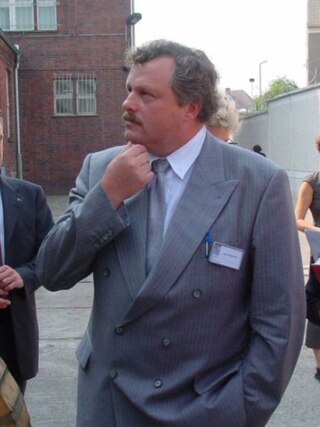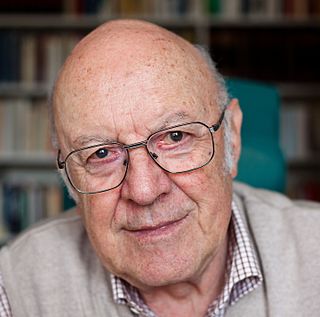Related Research Articles

The Ministry for State Security, commonly known as the Stasi, was the state security service of East Germany from 1950 to 1990.

The Felix Dzerzhinsky Guards Regiment was the paramilitary wing of the Ministry for State Security (Stasi), the security service of the German Democratic Republic (GDR).

Werner Teske was an East German Hauptmann (Captain) of the Ministry for State Security (Stasi). Teske was a senior intelligence officer in the Stasi's economic espionage division when he was accused of plotting to defect to West Germany with sensitive information and embezzled money. In the one-day trial, Teske was found guilty of espionage and desertion. He was sentenced to death and subsequently executed in June 1981.

The Main Directorate for Reconnaissance was the foreign intelligence service of the Ministry of State Security (Stasi), the main security agency of the German Democratic Republic, from 1955 to 1990.

The Medal for Exemplary Border Service was a national award issued in the German Democratic Republic (GDR). It was established on 28 May 1954, by the Council of Ministers of the GDR with Order No. 47/54 from the Ministry of Interior on 16 June 1954. The first presentation ceremony took place on 1 July 1954, to members of the German Border Police.

Siegfried Reiprich is a German human rights activist and author. He was involved in the resistance against the communist regime of the German Democratic Republic (GDR), which led to him being expelled from university and eventually banished from the GDR. In 2009, he was appointed by the Government of Saxony as the Director of the Stiftung Sächsische Gedenkstätten. In 2011, he was elected as a member of the Executive Board of the Platform of European Memory and Conscience.

Stasi Decorations and Memorabilia, by Ralph Pickard is a three volume in-depth analysis of the socialist political culture of the Ministry for State Security (Stasi) of the German Democratic Republic (GDR). It provides rare insight into this clandestine organization using never seen before artifacts such as medals, certificates and objects to document the Stasi culture of awards and recognition.(1,2) Altogether, all three volumes contain over 900 pages with over 1700 illustrations.

Zersetzung was a psychological warfare technique used by the Ministry for State Security (Stasi) to repress political opponents in East Germany during the 1970s and 1980s. Zersetzung served to combat alleged and actual dissidents through covert means, using secret methods of abusive control and psychological manipulation to prevent anti-government activities. People were commonly targeted on a pre-emptive and preventative basis, to limit or stop politically incorrect activities that they may have gone on to perform, and not on the basis of crimes they had actually committed. Zersetzung methods were designed to break down, undermine, and paralyze people behind "a facade of social normality" in a form of "silent repression".

Helmut Müller-Enbergs is a German political scientist who has written extensively on the Stasi and related aspects of the German Democratic Republic's history.
An unofficial collaborator or IM, or euphemistically informal collaborator, was an informant in the German Democratic Republic who delivered private information to the Ministry for State Security. At the end of the East German government, there was a network of around 189,000 informants, working at every level of society.
Jens Gieseke is a German historian. His work is focused on the German Democratic Republic and its Ministry for State Security.
Ilko-Sascha Kowalczuk is a German historian and author. His work is focused on the German Democratic Republic and its Ministry for State Security.
Karli Coburger is a former Major general in the East German Ministry for State Security . In 1984 he became, as matters turned out, the last head of the service's Central Department for surveillance, fact finding and arrests.

Karl Wilhelm Fricke is a German political journalist and author. He has produced several of the standard works on resistance and state repression in the German Democratic Republic (1949–1990). In 1955 he became one of several hundred kidnap victims of the East German Ministry for State Security, captured in West Berlin and taken to the east where for nearly five years he was held in state detention.
Heinz Fiedler was a major general in East Germany's Ministry for State Security (Stasi). Between 1970 and 1990 he was in charge of the organisation's Department VI which gave him responsibility for border security and tourist traffic. In December 1993 he hanged himself.
Manfred Döring is a former Major general (Generalmajor) with the East German Ministry for State Security (Stasi). He also served, between 1987 and 1990, as a commander of the elite motorised rifles regiment, the Felix Dzerzhinsky Guards.
Bernhard Elsner was a Major general in the East German Ministry for State Security (Stasi). During the course of a long career with the quasi-military ministry, between 1972 and 1987 he was Commander of the Felix Dzerzhinsky Guards Regiment.
Erich Bär was a resister against Nazism and later lieutenant colonel of Ministry of State Security (Stasi) of the GDR. He was, from 1957 to 1972 head of the executive offices of the Stasi in East Berlin.
Heinz Gronau was a communist resistance activist during the Hitler years. He was transferred to Buchenwald concentration camp in 1938. At the concentration camp he became a leading figure in the "International Buchenwald Military Organisation" . He survived the war and in 1946 joined the (semi-militarised) police service in the Soviet occupation zone of Germany. A succession of promotions followed. In 1966 he was promoted to the rank of Major general in the East German Felix Dzerzhinsky Guards Regiment. During the final years of his career he combined his overtly military posting with command of the National Department I at the Ministry for State Security ("Stasi"). The department was a specialist intelligence section of the ministry, tasked with attending to the intelligence needs of the ministry's armed units.
Harry Dahl is a former East German police officer who switched to homeland security in 1956. Within the Ministry for State Security hierarchy he achieved rapid promotion, reaching the rank of “colonel”. Between 1975 and 1985 he was in charge at the service's “Department XXII”, a specialist section dealing with counter-terrorism. After 1990 he came to wider attention with the discovery that he had been centrally engaged in highly secret collaboration between East German homeland security and the West German ”Red army faction” (RAF), an extreme leftist terrorist organisation active between 1970 and 1998 which was widely believed to have been responsible for over 30 murders in West Germany. Many of the key details concerning the extent and nature of Dahl's involvement in the relationship between the East German security services and the West German terrorist group remained unclear even after Dahl's trial and conviction in 1997.
References
- ↑ Vgl. Roland Wiedmann/Bernd Florath: Arbeitsgruppe des Ministers. In: Roger Engelmann/Bernd Florath/Walter Süß u. a. (Hrsg.): Das MfS-Lexikon – Begriffe, Personen und Strukturen der Staatssicherheit der DDR, Berlin 2011, S. 41.
- 1 2 Gieseke 2015, p. 177.
- 1 2 3 Schmeidel 2008, p. 115.
- ↑ "Geschichte der Spezialkampfführung (Abteilung IV des MFS)".
- ↑ Dennis & Laporte 2003, p. 205.
- ↑ Gieseke 2015, p. 180.
- 1 2 Gieseke 2015, p. 181.
- ↑ Gieseke 2015, p. 179.
- 1 2 "Fachbeiträge".
- ↑ Regine Igel: Terrorismus-Lügen. Wie die Stasi im Untergrund agierte. S. 190 f., Herbig, 2012, ISBN 978-3-7766-2698-8
- ↑ "Wehrmacht-Awards.com Militaria Forums - View Single Post - East German Parachute Units & Organizations". www.wehrmacht-awards.com. Archived from the original on 2016-10-10.
- ↑ Gieseke 2015, p. 178.
- 1 2 "Anti-Terror-Truppe der DDR | MDR.DE".
Bibliography
- Thomas Auerbach: Einsatzkommandos an der unsichtbaren Front – Terror- und Sabotagevorbereitungen des MfS gegen die Bundesrepublik Deutschland, Ch. Links Verlag, Berlin 1999.
- Dennis, Mike; Laporte, Norman (2003). "The Stasi: Myth and Reality".
{{cite journal}}: Cite journal requires|journal=(help) - Gieseke, Jens (2015). The History of the Stasi: East Germany's Secret Police, 1945-1990. New York: Berghahn Books. ISBN 978-1785330247.
- Schmeidel, John Christian (2008). "Stasi: Shield and Sword of the Party".
{{cite journal}}: Cite journal requires|journal=(help) - Tobias Wunschik: Die Hauptabteilung XXII: "Terrorabwehr" . In: Anatomie der Staatssicherheit. MfS-Handbuch III/16, BStU, Berlin 1995. (PDF, 237 KB)